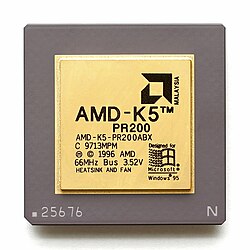(a bit more detail) |
|||
| Line 34: | Line 34: | ||
== Overview == | == Overview == | ||
| − | K5 was a result of desperation and frustration with cloning and second-sourcing [[Intel]]-based [[x86]] microprocessors. Rumors for the development of K5 dates back to mid-[[1993]], however it was only officially announced in late [[1994]] with the goal of releasing the first batch of chips in in [[1995]]. K5, which stands for [[wikipedia:Kryptonite|Kryptonite]] 5, which as its name implied was an ambitious attempt by AMD to take on Intel (being [[wikipedia:Superman|Superman]], metaphorically). The design suffered significant delays due to | + | K5 was a result of desperation and frustration with cloning and second-sourcing [[Intel]]-based [[x86]] microprocessors. Rumors for the development of K5 dates back to mid-[[1993]], however it was only officially announced in late [[1994]] with the goal of releasing the first batch of chips in in [[1995]]. K5, which stands for [[wikipedia:Kryptonite|Kryptonite]] 5, which as its name implied was an ambitious attempt by AMD to take on Intel (being [[wikipedia:Superman|Superman]], metaphorically). The design suffered significant delays first due to early design problems and later due to problems with various [[x86]] incompatibilities. The first few models were finally released in March of [[1996]]. |
| − | The {{amd|microarchitectures/k5|K5 Microarchitecture}} introduced many technical improvements over Intel's {{intel|Pentium}}, | + | The first version of {{amd|microarchitectures/k5|K5 Microarchitecture}} introduced, '''SSA/5''', had many technical improvements over Intel's {{intel|Pentium}}, making it well ahead of its time. It had an instruction translator that converted [[CISC]] instructions into simpler [[RISC]] instructions. Due to numerous manufacturing issues and design choices, K5 failed to deliver the expected performance it should have. |
| + | |||
| + | AMD went back and readdressed some of the deficiencies the SSA/5 design had. AMD introduced the new version of K5, named '''5k86''', in October of 1996. AMD had reworked the way memory gets accessed and flows through, from [[L1$]] to [[L2$]] and main. The results is upward of 35% performance improvements across the board. 5k86's performance outmatched Pentium's with lower clock speed. | ||
== Architecture == | == Architecture == | ||
{{main|amd/microarchitectures/k5|l1=K5 Microarchitecture}} | {{main|amd/microarchitectures/k5|l1=K5 Microarchitecture}} | ||
Revision as of 21:38, 25 July 2016
| AMD K5 | |

| |
| K5-200 | |
| Developer | AMD |
| Manufacturer | AMD |
| Type | Microprocessors |
| Introduction | October 24, 1994 (announced) March 27, 1996 (launch) |
| Production | 1996 |
| Architecture | Pentium-compatible superscalar microprocessors |
| ISA | IA-32 |
| µarch | K5 |
| Word size | 32 bit 4 octets
8 nibbles |
| Process | 500 nm 0.5 μm , 350 nm5.0e-4 mm 0.35 μm
3.5e-4 mm |
| Technology | CMOS |
| Clock | 75 MHz-133 MHz |
| Package | SPGA-296 |
| Socket | Socket 5, Socket 7 |
| Succession | |
| ← | → |
| Am5x86 | K6 |
K5 was a family of microprocessors designed by AMD and introduced in 1996. K5 models directly rivaled Intel's Pentium processors. These processors were based on AMD's K5 Microarchitecture which was their first x86 microarchitecture to be designed in-house from the ground up without licensing or reverse-engineering Intel's architectures.
Overview
K5 was a result of desperation and frustration with cloning and second-sourcing Intel-based x86 microprocessors. Rumors for the development of K5 dates back to mid-1993, however it was only officially announced in late 1994 with the goal of releasing the first batch of chips in in 1995. K5, which stands for Kryptonite 5, which as its name implied was an ambitious attempt by AMD to take on Intel (being Superman, metaphorically). The design suffered significant delays first due to early design problems and later due to problems with various x86 incompatibilities. The first few models were finally released in March of 1996.
The first version of K5 Microarchitecture introduced, SSA/5, had many technical improvements over Intel's Pentium, making it well ahead of its time. It had an instruction translator that converted CISC instructions into simpler RISC instructions. Due to numerous manufacturing issues and design choices, K5 failed to deliver the expected performance it should have.
AMD went back and readdressed some of the deficiencies the SSA/5 design had. AMD introduced the new version of K5, named 5k86, in October of 1996. AMD had reworked the way memory gets accessed and flows through, from L1$ to L2$ and main. The results is upward of 35% performance improvements across the board. 5k86's performance outmatched Pentium's with lower clock speed.
Architecture
- Main article: K5 Microarchitecture
| This section is empty; you can help add the missing info by editing this page. |
Members
| This section is empty; you can help add the missing info by editing this page. |
| designer | AMD + |
| first announced | October 24, 1994 + |
| first launched | March 27, 1996 + |
| full page name | amd/k5 + |
| instance of | microprocessor family + |
| instruction set architecture | IA-32 + |
| main designer | AMD + |
| manufacturer | AMD + |
| microarchitecture | K5 + |
| name | AMD K5 + |
| package | SPGA-296 + |
| process | 500 nm (0.5 μm, 5.0e-4 mm) + and 350 nm (0.35 μm, 3.5e-4 mm) + |
| socket | Socket 5 + and Socket 7 + |
| technology | CMOS + |
| word size | 32 bit (4 octets, 8 nibbles) + |